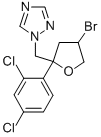Uses
Bromuconazole is used on winter wheat and barley for the control
of foliar mildews, rusts and other diseases.
Uses
Agricultural fungicide.
Definition
ChEBI: A member of the class of oxolanes carrying 1,2,4-triazol-ylmethyl and 2,4-dichlorophenyl substituents at position 2 as well as a bromo substituent at position 4. A foliar applied conazole fungicide for a range of crops including cereals, fruit, vegetables
and vines.
Metabolic pathway
Bromuconazole is a relatively stable compound which is not readily
hydrolysed, is quite persistent in soil and is subject to relatively slow
photodegradation. It is metabolised in plants but the parent compound
tends to be the major residue. However, bromuconazole is almost completely
metabolised in animals and birds (chickens) and its metabolites
are rapidly eliminated.
As with many other triazole fungicides, metabolism is very complex.
Bromuconazole exists in four forms (two diastereoisomeric pairs). There
are numerous sites available for biotransformation (lack of regioselectivity)
and there is also a lack of stereoselectivity at most sites. For example,
there are also four forms of metabolite 5 (4-hydroxybromuconazole) (two
diastereoisomeric pairs as with bromuconazole itself). Oxidation of
secondary alcohols to ketones and the thiolation of certain sites further
complicate the picture. Thiolation presumably occurs via the involvement
of glutathione but mercapturic acid conjugates (N-acetylcysteines)
do not appear to have been isolated.
Bromuconazole has been the subject of an evaluation by the Pesticide
Safety Directorate of UK MAFF. All of the information presented below is
derived from this source (PSD, 1996). All reported radiolabelled studies
were conducted using [
14C-phenyl]bromuconazole.
Degradation
Bromuconazole was found to be stable in buffer at pH 5,7 and 9 at 25 °C
over 30 days.
Aqueous photolysis using filtered light to simulate mid-summer sun at
50" N conducted at 25 °C and pH 4 caused slow photodegradation. The
DT
50 of bromuconazole was 18.2 days. Over 28 days a 10% yield of CO
2
was obtained and six or more photoproducts were detected with none
accounting for more than 8% of the total. No degradation occurred in dark
controls.


